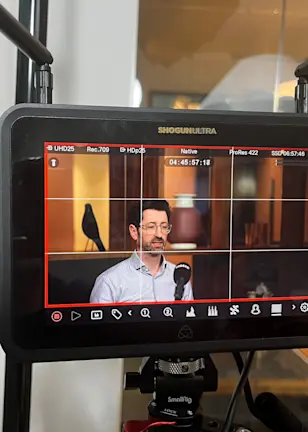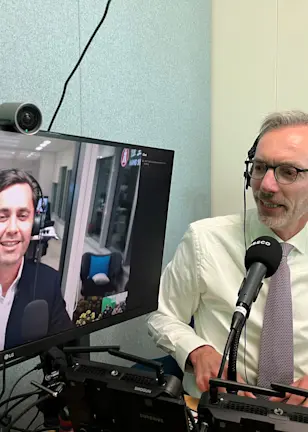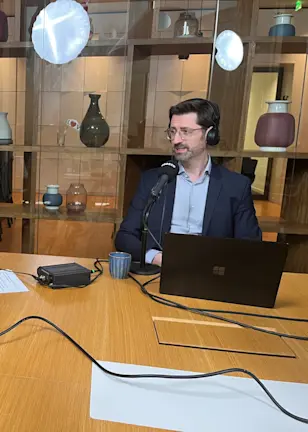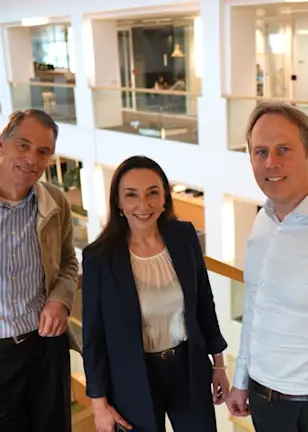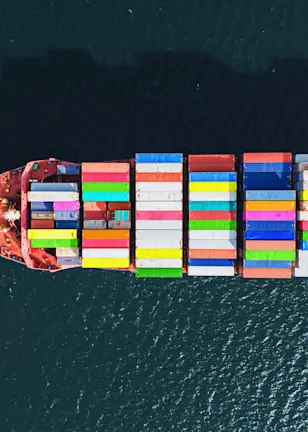Transcript
We do not guarantee the accuracy of this transcript.
This podcast is for professional investors only.
Erika van der Merwe (EM): Sustainable investing continues to evolve, and we've seen the progress as new research comes to light on matters related to the environment, to climate specifically, and to society more broadly. A refinement of regulatory frameworks has been part of the driving force of change.
Welcome to a new episode of the Robeco podcast.
EM: A more recent aspect of the evolution in sustainable investing is the emphasis on what's termed ‘transition finance’. Transition finance or transition investing is a broad concept, and some argue it's too broad, but there are strong views that the complex shift that we need to get our economies to net zero will depend on this form of capital.
Now, how are investors going about the process of transition investing? What are their priorities, and would have been the lessons learned so far. Thu Ha Chow and Lucian Peppelenbos both join me for this discussion. Thu Ha is Robeco’s head of fixed income in Asia. And Lucian Peppelenbos is Robeco’s climate and biodiversity strategist. Welcome to both of you.
Both: Hi. Nice to be here.
EM: What's understood in both the investment community and the academic field by the term ‘transition finance’, Lucian?
Lucian Peppelenbos (LP): Well, so, one of the key articles of the Paris Agreement is that financial flows should be aligned with the goals of the Paris Agreement to keep temperature well below 2°C and transition finance. So if net zero is the destination where we want to be in 2050, then transition finance is the journey to get there. It's the financial flows to transform the global economy from brown into green. And lately the term has become really fashionable because, well, first we thought “Let's invest in climate. So let's invest in windmills and solar panels etc. Those are the green solutions.” But actually the big chunk of finance should go to brown industries becoming green: cement and steel and aviation, you name it. And that's where the term transition finance is being used for.
EM: So that's a good point then to have, that there's a distinction between a transition finance and just green investing. So you as a bond investor would have for instance looked in particular at green bonds. So this goes beyond that though.
Thu Ha Chow (TC): It has. And I was looking at this morning. So IMCA has actually said actually there's three broad – this is why it gets so confusing because these same terms are used slightly differently by other different investors, so it's quite important – so there's actually kind of three broad categories in which that term is used. There's one they call ‘the wide lens’ definition which is an economy-wide transition. So that's kind of in alignment with the – so the G20 Sustainable Finance Report talks about that. That's including the SDGs, and biodiversity, the circular economy. So that's a wide definition.
And then secondly there's a climate transition as aligned by Paris. That's another terminology that's used for transition financing. And then there's a very narrow [definition] which is also again [for] some of the hard to abate sectors where that is now the emphasis on. So because these terms and this classification is used interchangeably by different people, meaning different things, that's actually what has caused some confusion. Some say it's very broad in some sense, some say it’s very narrow. And they're both right in different contexts.
EM: But what about the controversy? For example, this is a quote from Barclay’s Global Head of Sustainable Finance, Daniel Hanna, who says that, if you look at it from the outside, there might be concerns that by putting capital to work in some of these so-called ‘hard to abate’ sectors, you're effectively greenwashing. So for an outsider saying, well, you're putting capital to work in a dirty industry, how could that be positive?
LP: Yeah. So there's certainly a risk of greenwashing here if you don't have the right definitions and the right measurements to make it very clear. And so in transition finance, a couple of principles are very critical. First of all, the ambition level of the transition and any transition plan should be science-based in line with Paris. So you need to measure that. You need to demonstrate that.
Secondly it's good to have targets but they also need to be credible. You need to trust that the organization that is issuing the bond or what you want to invest in, that is actually going to deliver on that transition. So how do you demonstrate the delivery, the credibility of those targets? And then the third principle is about transparency. So the issuer needs to be transparent about how the finance is used and what the progress is, what the results are. And if those things are not in place – ambition, credibility and transparency – then of course there's a risk of greenwashing.
EM: Thu Ha, why this growing focus now on transition? If we can go a little deeper into the thinking behind that, is this just a pure business case? Because we keep hearing about the trillion dollar annual gap or trillions of dollars needed to get us there.
TC: So I think it arrives because I think that the fear of greenwashing is quite important. And if you are going to be very purist and green, it actually only applies to a very, very specific segment and certain sectors. We know that actually those segments in themselves, the very people, keep them very pure in their definition of green. They don't apply to other sectors. And this other classification of transition finance is more broad.
But as Lucian says, because it's broader and it applies to multiple sectors, it requires another kind of guardrails to make sure that it doesn't become a kind of an ‘all in’ for everything. So I think it's resulting from a need to keep green very green. So you can't start pushing the other kind of definitions into that. But then you need another definition to take into account of other sectors which are actually as critical to moving us towards a lower carbon economy.
EM: Um, just as a side note, I read a piece by RMI. They’re a research and consulting organization in the field of sustainability. They say they analyzed 17 different transition finance frameworks and argued that there were effectively 17 different definitions of this. Thu Ha, just an add on question here. Do you see social impact as being part of the goals of transition finance?
TC: So I mean, it's very funny you should say that because very, just very recently, literally a few days ago, the ASEAN taxonomy have actually just revised their vision and they've actually put in that as the ‘Just Transition,’ the social element to be an important because there's a recognition that you can't do one without the other because of public backlash.
But the fact that energy security and energy accessibility is also very much a part of this kind of energy transition. So as you say, it becomes more complex. Then as it becomes more, as it encompasses more things, as you say, you run a risk of putting everything in the same bucket. So back to what Lucian says. It's very important when you start doing that, to actually make sure that guardrails are actually put in to ensure that those activities are actually focused into that area.
EM: Lucian, what has Robeco's approach been in doing this? You identified the three key elements in a framework in such an approach, so that what you are doing?
LP: Yeah. So we've done a lot of research on this, and we developed a couple of metrics that we can use in our funds. Those metrics are aligned with those – well, maybe not all 17, but a lot of those international frameworks that have been put out. One of our metric is what we call the Climate Traffic Light. So it measures the targets, the carbon reduction targets of a company. It measures whether those targets are in line with the Paris Agreement, and it measures the credibility of those targets. And that comes together in a traffic light where companies get a green color if they're doing good job, amber if they are on their way, and red if they are misaligned. And for us, green companies, they can be part of a transition and a climate strategy.
EM: I want to interrupt you because I gather that there are more elements to this framework, but this traffic light – so these aren't just numbers that are going to pop out of some database in the sky. You, as an investment house, would need to go and do the analysis to decide if that company's targets are credible, right?
LP: Exactly. This metric is based on sector-specific modeling, how we take the carbon reduction pathway that is valid for steel or for cement. How should it decarbonize over time according to science and policy? And then we take the target data of companies and their emission data, and we see, okay, how do they perform against that sector benchmark? So it's sector-specific modeling. And then for the credibility assessment of those targets, you can imagine even more data points around capex, around historic emission reduction. But also is the strategy embedded in the governance in the incentives of a company? Do we see the right disclosures, etc? So we take a lot of data points, we have probably around 15 data sets that go into this single metric.
EM: How good is your coverage now?
LP: Well, we cover roughly 15,000 companies globally. So that's a lot. And for some segments of the market, the data is better than others. But yeah, we have good global coverage…
EM: …for equity and fixed income investors.
LP: Yes.
EM: I feel that we do have to come back to that framework. But I just want to bring Thu Ha in here. So Thu Ha, are you then, on a daily basis as a fixed income investor in the Asian region, relying on these data sources?
TC: Yes, definitely. I think, as you say, as an investor, we are constantly having to actually try to navigate a very complex world with things link, right? So every extra data point that actually gives you a greater insight to actually link with what the company is doing is very helpful. And having these extra data points to kind of articulate these things become very valuable, and [it is] something I feel as a competitive advantage to me as an investor versus not having it.
EM: So Lucian that's the traffic light. What are the other components?
LP: Yeah. So the traffic light is for the green companies are what we call ‘transition leaders’. There's another metric we use which is the Climate Solution Score. And that measures how well is a company contributing to real climate solutions. So that's where the solar panels and the windmills come in, or for example, bicycles also. And so those are all activities that are identified in, for example, an EU taxonomy. But also, we base ourselves on climate science directly, the reports from the UN Climate Science Panel, the IPCC. And we measure, okay, how much green revenue does a company have according to those activities? And this metric we use to identify climate solution providers.
EM: So such a company could itself be heavy emitting, but it's contributing to the solution.
LP: Exactly. So transition companies are heavy emitters that reduce their emissions over time within their own industry, within their own supply chain. And climate solution providers, they offer solutions for others to decarbonize: they help the decarbonization of the wider economy.
EM: So is that the full framework then, that that you as a house have available?
LP: And then we have a third framework, which is our green bond framework, which we have been working with already for a number of years. And that's a well-established five steps approach where we scrutinize any bond that is issued and whether it complies with our definitions of it being green.
EM: Thu Ha, does all of this make sense? You refer to the ASEAN Taxonomy, but if you're investing in a particular region or if you're investing globally, does it make sense to align such frameworks that may or may not be relevant to a particular country or region or sector?
TC: All data and all information is relevant regardless, right? It's just the – it's like I say, it's like looking at an EBITDA number. All vary from region to region, but we all use it. So it doesn't matter which region you're in. In fact, for emerging market regions it may actually become much more critical. It's not an extra data point rather than less, even though getting the numbers may be a bit more onerous because of the lack of data point.
But I think as a portfolio manager, I always think that what is provided by SI and our research are the raw ingredients, the portfolio, and the manager needs to actually make it into something that someone wants to actually buy and eat. So we take all of these various elements and we kind of go, okay, actually what is applicable to emerging markets or to equities into bonds? And we go, actually, you know, what can I use of these tools to actually create a product that is actually helpful to both my investor base, but also actually in moving the world in the right direction of asset allocation? So we actually take these tools and actually then we actually try to compose it into a product or a solution.
EM: Lucian, how far back does this process date of creating this database? And that the traffic light methodologies – it’s been about 2 or 3 years?
LP: Yeah, that's more than two years now. We started in early 2021.
EM: So there's quite a team of researchers and specialists involved in this. So it's no small task.
LP: It's a team of specialists where we have sector specialists contributing to the sector pathway of steel, cement, aviation. And we combine that with data science because you can imagine we were covering 15,000 companies, but fundamentally we probably cover about 1,000 companies. And then with data science, we automate the scores and we extend it to the entire universe. So it's really a combination of researchers and data science that makes this possible.
EM: So what have you learned in the process? What do you know now that you didn't know two, or two and a half years ago? I'm sure you would have adapted your process along the way.
LP: Absolutely. These models – you don't have them right from one day to another. There's a lot of tweaking to it. For example, to get the right sector benchmark, we use those from science. We get them, for example, from the transition pathway initiative. But then when you apply it, you run into a million issues: that you don't have the right data or that data uses different units and no – to get all of that right, that’s why it takes two years.
EM: And Thu Ha, for you, what have been the learnings as you expand your portfolios in this area?
TC: I think when we all started looking at, like you said, this journey on sustainable investing, it felt quite alien from what we used to do in like financial – when we looked at accounts. And if you think about the whole accounting system that we use, the financial accounting that's taken more than 100 years to evolve, right> And now we are looking at new data sets that are that are evolving very quickly.
So at the beginning, I think it was just about adjusting to understanding how you use that in the context of how you invest. But as things have evolved you realize you're doing exactly the same thing you had used financial data for: to make an assessment in a company with your sustainable data. So it's become, over that process, the alignment and the way that you use the information to make your decision. [That] has converged a bit. And that's been the biggest change in the way – that instead of just an overlay something that it's just foreign, it becomes very much integrated. And part of how you think about an investment.
EM: But then a very specific practical question, Thu Ha, for example, which benchmark would you use in such a portfolio, a transition-investing portfolio.
TC: So I think when we have done – when we've structured portfolios, we keep to the regular benchmark because we don't think that transition or sustainable investing should return anything, or should have a lower or different return target than any investment returns.
Because ultimately we are asking the same question: Which companies are going to navigate this new environment that we think that we're going into this new landscape in the best manner? Having an extra sustainable or transition lens just means I asked that question from a different angle as well as my financial angle. It doesn't actually change the investment philosophy in a radical way. So that's why we've always used the same benchmarks as we do for just a regular investments benchmarks.
EM: Lucian, in assembling this process, would you say, just sort of looking back at this, does this process of investing in transition-friendly companies, do you think it favors certain asset classes? So I mean, I read, for instance, it could favor debt more than equity as an investor.
LP: Well, that's certainly where it started. So the first discussions on transition finance was through the issuance of green bonds that that had a transition component. I remember the bond which was issued by Repsol. That really was the start of this discussion. Can a bond of an oil and gas company being regarded as a transition finance? Of course, yes, in that sense, bonds, they are issued with certain – the proceeds are for certain purposes and that's why it came first.
But actually it is the whole concept of transition finance is as well applicable to equity. That's also the maturing that we've seen and the topic being more on top of the agenda, I think it's equally applicable currently to bonds and to equity.
EM: Thu Ha, what are you hearing from clients and potential clients or even just broadly the asset owner community regarding transition finance? So you know, what feedback are you getting? Do you feel you should adapt your process?
TC: In Asia, it's really been a topic that has been very topical for over a year, if not longer. And that's because so many of the high emitting sectors are actually located in this region. And the fact that unless they deal with these sectors – it's just the economies can't transition. So it's a real problem. It's a problem statement that needs to be solved. We have got very positive feedback of the fact that we're thinking much more holistically about the problem, rather than – someone said to me that you guys are trying to move greener rather than look green.
It's easy to look green, but it's actually a lot harder work to go underneath, find out the problem and start to solve some of those problems. For example, the fact that some financing is – I mean, green bonds are a good place to start, but a green bond is the – proceeds needs to move a company. And unless the company, the transitioning company is the one that maybe use green bond proceeds to help themselves along that journey.
So then how do then think through that? How did they use the proceeds and how does the whole process work as companies and economies transition? Because hopefully you will get more and more companies that are becoming in line with transition leaders – is what we call the term. But they have to start somewhere and they may need green bonds to help them, you know, proceeds to help them actually move in the right direction to change their business model. So it becomes a very dynamic way of thinking about your investment universe and how it moves through the cycle. As we move from one status quo into a different paradigm.
EM: You're especially passionate about emerging markets and frontier markets and really the opportunity to bring about fundamental and real change that that changes lives. So do you see this as especially applicable to emerging markets as opposed to developed markets?
TC: You actually need both because an ecosystem actually needs all different types of things. So you do need some of the technologies that are being developed in developed markets. Some of the technologies that can only be kind of developed there because of the capital and the intellectual capital, as well as the physical capital that's needed.
But of course, it needs to be applied to where the highest impact needs to happen. I think this kind of ‘them’ and ‘us’ classification is probably something that we should do away with and actually think like how we think about the ecosystem: “How does one part of the system help another part of the system?” Because the ultimate goal isn't “Which country decarbonizes fastest?” [The question is,] “how does the world decarbonize?” That's the end game rather than which company – and how we as a financial industry pivot to make sure that that happens because the impacts as well – when we haven't even talked about adaptation – but the impact on the climate on those regions are actually also something that we have to deal with at some point as well.
EM: Yes. Strong points. Lucian, you're a busy man. You really plugged into the broader investment community around these topics. Also the academic field, what's the feedback that you're getting? And given all of that, how do you see the road ahead in terms of these research methodologies changing and improving?
LP: Yes. So my sense from the market and the different networks that we participate is that people are a bit cautious about this. The fear of greenwashing is huge. That's why this focus on research, on getting the right data, the right models and being aligned with standards, with frameworks, is critical. We will continue to push that. We will push the data, will advance the models, will contribute to the emergence of clear market standards. And I think that's the way forward because we need transition finance. We need to go from brown and green. So we need to get this right.
EM: So lots of exciting things happening here behind the scenes in future. What can the world expect from Robeco?
TC: Well, I'm really excited because I do think we are really ahead in terms of the research that we've done. The IP is ready, we've tested some of the stuff in our investment process already, and now it's really about putting it all together and creating products that will actually improve the whole landscape of transition financing.
EM: Lucian, thank you very much. Here in Rotterdam with me and Thu Ha from Singapore. So good hearing your perspectives on this topic. Thank you.
TC: Thank you, Erika.
LP: Thank you.
EM: And to listeners, thanks to you for being part of this conversation. Check out the full podcast series. We publish a new episode every month covering a range of investment-related topics. If you subscribe, you'll receive a notification as soon as the new episode is published. In the meantime, please rate the show and share the show link with a friend. This monthly podcast and Robeco’s biweekly In Tune with the Markets podcast, both available on all major podcast platforms and on the Robeco website. Until next time.
Thanks for joining this Robeco podcast. Please tune in next time as well. Important information. This publication is intended for professional investors. The podcast was brought to you by Robeco and in the US by Robeco Institutional Asset Management US Inc, a Delaware corporation as well as an investment advisor registered with the US Securities and Exchange Commission. Robeco Institutional Asset Management US is a wholly owned subsidiary of ORIX Corporation Europe N.V., a Dutch investment management firm located in Rotterdam, the Netherlands. Robeco Institutional Asset Management B.V. has a license as manager of UCITS and AIFS for the Netherlands Authority for the Financial Markets in Amsterdam.








